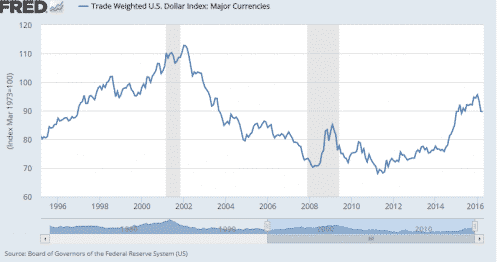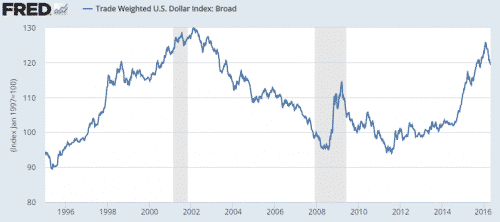Fed policy in an election year of slowing growth
US and global economic growth is slowing. And this has caught the Fed out given its rate hike in December. The question, now, therefore is whether the Fed continues to hike in the face of this slowing, given the election looming in November. I believe the window for hikes is so limited that the data in May and June will determine what happens for the rest of the year. Let me add some thoughts on these issues and on policy divergence below.
Before I get to the Fed’s growth-based policy dilemma, let me address the policy divergence dilemma and the rumored Shanghai Accord. Here’s the long and short on this. If one looks at the broad-weighted or narrow US dollar index, it is clear that there has been a huge spike up starting from mid-2014.
This spike upwards put the US dollar at one of its highest levels in the last 20 years after the Fed raised rates in December and asset markets tanked in January and February. Much of this owed to not just dollar strength but also emerging market weakness as the commodity complex broke down. But the driving factor here was the fact that the US dollar as the world’s reserve currency had been used as a funding currency for many EM corporates. And the divergence of policy between the Fed and the rest of the world made that funding more and more expensive – to the point where it spilled over into financial instability in January and February.
Before the market dislocation, the Fed seemed oblivious of the risks of policy divergence. But once the markets fell out of bed, the Fed was forced to backpedal from its 300 basis point hike policy path in December to a much less aggressive path. But policy divergence is still in place, as the Fed’s tightening bias remains, while all other major central banks are easing aggressively.
The talk in markets since then is of a Plaza Accord-like agreement from the G20 in Shanghai, where the Fed promised to dial back on its tightening in order to give the Chinese more breathing space, since their currency peg was creating currency outflow pressure via either capital flight or a need for US dollar funding by Chinese corporate debtors. I am sceptical that such an accord exists because we are in an age of diminishing growth expectations in which policy coordination of that sort simply doesn’t happen very easily. Moreover, given that every central bank is easing except the Fed, all of the Accord demands would fall on the Fed. And none would fall on others.
Even so, everyone is now on notice that policy divergence is indeed dangerous. And I reckon the Fed is more cautious because of it. But of course, there are the slowing domestic and international growth expectations too. And this is why the Fed is on hold for the foreseeable future. There will be no hike today. The question then becomes one of gauging how furiously the Fed will have backpedaled toward neutral from a tightening bias. We can gauge this from the balance of risks statement, the inflation wariness, and the number of dissents we get, if any.
Let’s remember that the Fed is ‘committed’ to two rate hikes in 2016 if the pace of growth does not slow further. In an election year, you won’t see two hikes in September through December because it politicizes the Fed. Therefore, to the degree we actually do get two rate hikes, at least one has to be in the summer. And for the summer hike to happen, the Fed’s forward guidance has to be in place ahead of time. That means the policy statement today will be critical in assessing how much the Fed has eased off the brake.
If equity markets sense the Fed statement is dovish, it gives equities more room to rally despite the breakdown in earnings. The bull market is long in the tooth but it is not over yet.


Comments are closed.